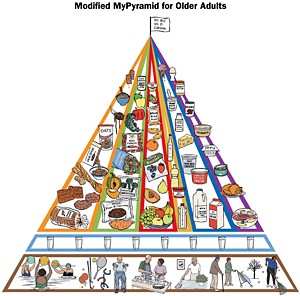In order to stay in line with the new U.S. Department of Agriculture (USDA) food pyramid guidelines, researchers at Tufts University in Boston have developed a modified version specific to older adults, ages 70 and above.
The new USDA guidelines are Internet-based. Lead researcher Alice H. Lichtenstein, D.Sc., director of the Cardiovascular Nutrition Laboratory at the Jean Mayer USDA Human Nutrition Research Center on Aging, was concerned about seniors' ability to access the new online food pyramid system.
Their answer was to translate the modified food pyramid into graphic form, which could be used either with print or online materials. Icons are used to represent food and fluid intake in the following categories, as well as suggested physical activities:
- Whole, enriched and fortified grains and cereals such as brown rice and 100 percent whole-wheat bread.
- Brightly colored vegetables such as carrots and broccoli.
- Deeply colored fruit such as berries and melon.
- Low- and non-fat dairy products such as yogurt and low-lactose milk.
- Dry beans, nuts, fish, poultry, lean meat and eggs.
- Liquid vegetable oils and soft spreads low in saturated and trans fat.
- Fluid intake.
- Physical activity such as walking, house work and yard work.

The new pyramid was featured in the January 2008 issue of Journal of Nutrition. Lichtenstein et al. noted in the abstract: "We now propose a Modified MyPyramid for Older Adults in a format consistent with the MyPyramid graphic. It is not intended to substitute for MyPyramid, which is a multifunctional Internet-based program allowing for the calculation of individualized food-based dietary guidance and providing supplemental information on food choices and preparation. Pedagogic issues related to computer availability, Web access and Internet literacy of older adults suggests a graphic version of MyPyramid is needed. Emphasized are whole grains and variety within the grains group; variety and nutrient density, with specific emphasis on different forms particularly suited to older adults' needs (e.g. frozen) in the vegetables and fruits groups; low-fat and non-fat forms of dairy products including reduced lactose alternatives in the milk group; low saturated fat and trans fat choices in the oils group; and low saturated fat and vegetable choices in the meat and beans group. Underlying themes stress nutrient- and fiber-rich foods within each group and food sources of nutrients rather than supplements. Fluid and physical activity icons serve as the foundation of MyPyramid for Older Adults. A flag to maintain an awareness of the potential need to consider supplemental forms of calcium, and vitamins D and B-12 is placed at the top of the pyramid. Discussed are newer concerns about potential over-nutrition in the current food landscape available to older adults."
Lichtenstein elaborated further on the need for the modified food pyramid, "Older adults tend to need fewer calories as they age because they are not as physically active as they once were and their metabolic rates slow down. Nevertheless, their bodies still require the same or higher levels of nutrients for optimal health outcomes. The Modified MyPyramid for Older Adults is intended to be used for general guidance in print form or as a supplement to the MyPyramid computer-based program."
References
- USDA Food Pyramid. Available at: www.mypyramid.gov.
- Tufts Researchers Update Their Food Guide Pyramids for Older Adults. Available at: http://nutrition.tufts.edu/ 1197972031385/Nutrition-Page-nl2w_1198058402614.html.
- Lichtenstein AH, Rasmussen H, Yu WW, et al. Modified MyPyramid for older adults. J Nutr, 2008;138:78-82.




